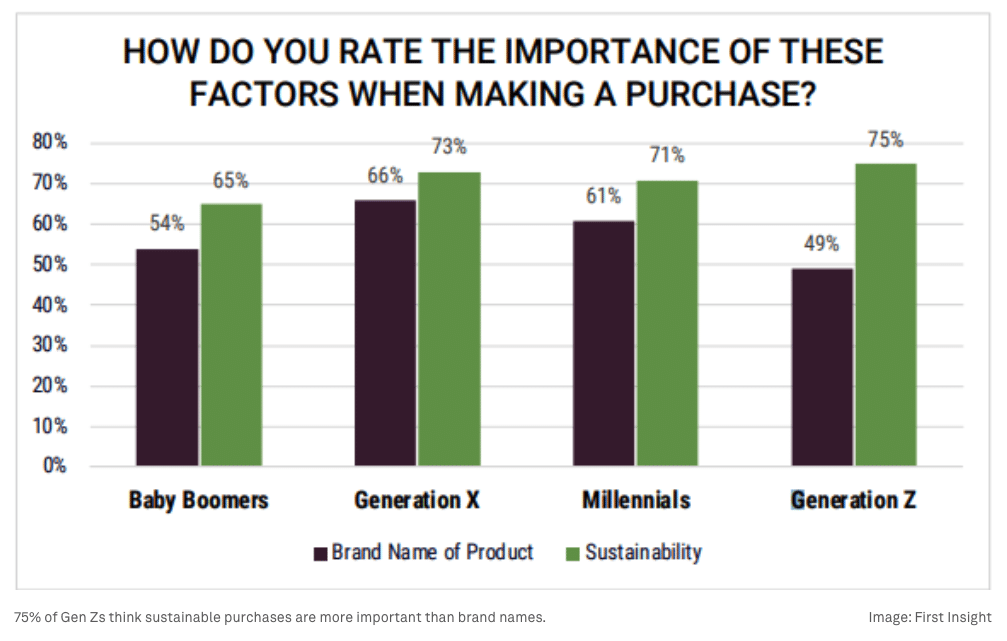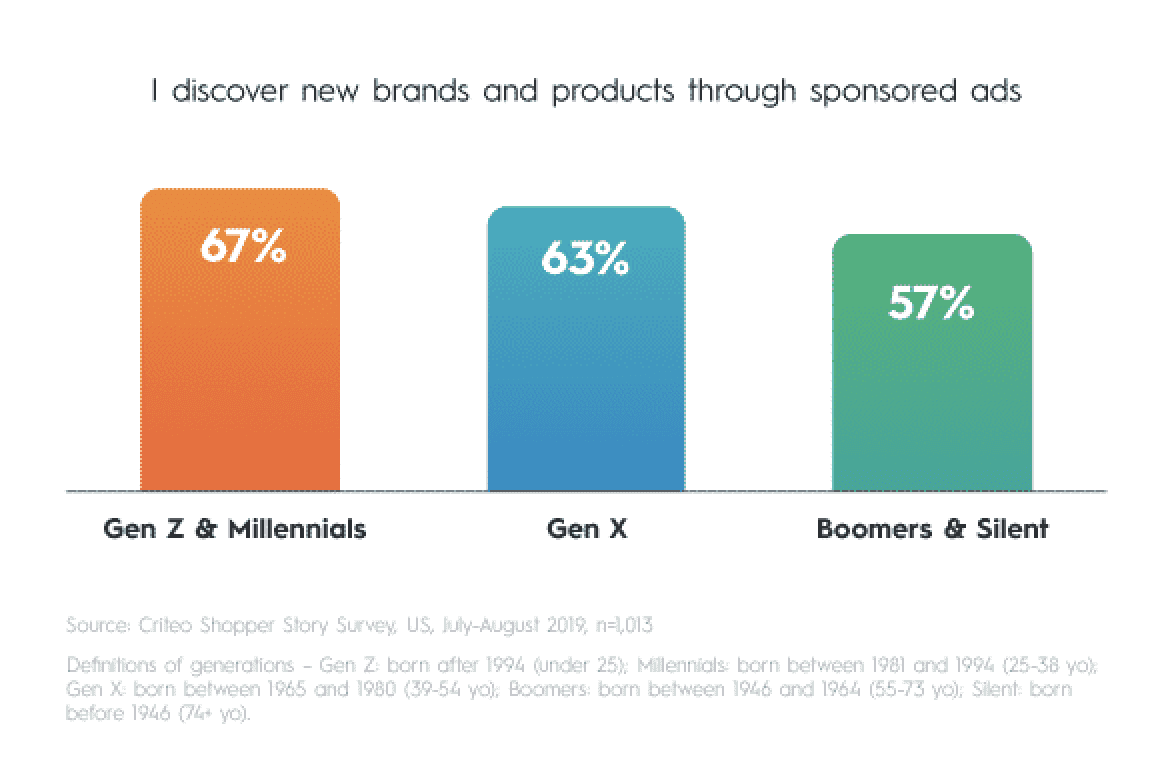Where does Gen Z shop online?
16/04/24
9'
Gen Z online shopping is transforming the digital marketplace, setting trends that redefine what it means to engage with brands and products in the virtual world. With their smartphones in hand and a deep passion for sustainability and innovation, this generation is not just browsing—they’re revolutionizing retail.
In this article we dive into the digital haunts where Gen Z spends, influencing the future of online shopping with every click and swipe. Get ready to explore the platforms and practices that make Gen Z’s shopping habits a beacon for what’s next in e-commerce.
Gen Z: Who are they, what do they want?
Some key figures first
Generation Z, colloquially known as Gen Z or Zoomers, marks the cohort born between the mid-1990s to the early 2010s, navigating the cusp of the millennium transition. This diverse group, spanning across a broad age range, embodies the quintessence of digital nativity, having been raised in an era where technological advancements and social media were not just emerging phenomena but a constant presence. With an estimated global population of approximately 2.47 billion, they represent a formidable force, both in demographic significance and economic influence.
This generation distinguishes itself through a blend of pragmatism and digital savviness, characteristics shaped by their unique socio-economic upbringing. Witnessing the financial tumult of the 2008 Great Recession, Gen Z has adopted a notably cautious approach to spending, demonstrating a marked preference for value and sustainability over mere brand recognition. This economic circumspection does not, however, dampen their spending power. Reports indicate that older members of Gen Z account for about 40% of global consumer spending, amassing to roughly $143 billion, with a significant portion deriving from allowances—a testament to their burgeoning financial influence.
Important characteristics
Gen Z’s shopping behaviors underscore a shift in retail dynamics. As digital natives, they exhibit an intrinsic propensity towards mobile and online platforms for their shopping needs, leveraging these mediums for everything from product research to price comparisons and seeking discounts. This mobile-first orientation has profound implications for retailers, underscoring the necessity to engage this demographic through digital landscapes effectively.
Moreover, this generation’s shopping ethos is deeply intertwined with social media. Platforms such as Instagram, Snapchat, and TikTok are not mere channels of communication for them; they are dynamic spaces for inspiration, expression, and connection with brands. This paradigm shift has catapulted social commerce to the forefront, with Gen Z’s preferences shaping the trajectory of retail marketing strategies. Their reliance on influencers over traditional advertising, coupled with a strong desire for authenticity and sustainability, outlines the contours of a more conscientious consumer base.
Despite their digital inclination, the in-store experience retains its allure among Gen Z shoppers, with a significant majority still favoring physical retail encounters (only 2% never shop in-store). This paradox highlights the complexity of their shopping preferences—a blend of digital convenience and tangible engagement.

How do they shop online?
Sustainability as a core purchase driver
Sustainability emerges as a critical factor in the purchasing decisions of Gen Z consumers. 73% express willingness to pay a premium for products that are sustainable, underscoring a preference for quality and eco-friendly options. This sentiment is further amplified by findings from the Deloitte Global 2022 Millennials and Gen Z Survey, which reveals that a significant majority (64%) would opt for sustainable alternatives even at a higher cost, eschewing cheaper but less eco-conscious options. For brands, aligning with Gen Z’s sustainability ethos is not just about offering products but also embodying their values and stances on broader societal issues.

Fiscal prudence over impulse buys
In contrast to the millennial penchant for credit purchases, only 19% of Gen Z shoppers exhibit a willingness to buy on credit. This fiscal conservatism reflects a generation shaped by economic uncertainty, prioritizing savings and value over indebtedness.
The social media marketplace
With 70% of teenagers viewing YouTube personalities as more relatable than traditional celebrities, influencer endorsements play a crucial role in shaping perceptions and driving sales.
Social media platforms are pivotal in Gen Z’s shopping journey, serving as a primary avenue for brand discovery and product purchases. The influence of platforms like Instagram is profound, with 60% of Gen Z in the US utilizing it to uncover new brands and offerings. Moreover, nearly 80% of Gen Z and millennials have been swayed by their social media feeds to make a purchase, highlighting the critical role of social media in modern consumerism.
The authority of (social media) influencers on Gen Z’s purchasing decisions cannot be overstated. With 70% of teenagers viewing YouTube personalities as more relatable than traditional celebrities, influencer endorsements play a crucial role in shaping perceptions and driving sales. This transition from traditional advertising to influencer marketing is a strategic pivot retailers must undertake to resonate with this audience.

Omnichannel engagement
Gen Z’s shopping habits are genuinely omnichannel, integrating both digital and physical retail experiences seamlessly. According to a 2023 Near Intelligence study, Gen Z and Millennials are twice as likely to engage in omnichannel shopping.
Their expectations span across convenience, payment diversity, and exceptional customer service, demanding technological integration across all shopping platforms. This holistic approach to shopping underscores the importance of a unified retail strategy that caters to Gen Z’s multifaceted preferences.

Augmented Realities (AR) and virtual experiences
Gen Z’s inclination towards technology extends into the realm of shopping experiences, with a marked interest in augmented reality (AR) and the metaverse. Surveys indicate a strong curiosity in AR for visualizing products in real-world settings, and a significant engagement with metaverse activities for socializing, gaming, and attending virtual concerts. This openness to new technological frontiers suggests a future where shopping is not just transactional but a multifaceted, immersive experience.
Industry-specific trends
Gen Z’s shopping frequencies and preferences exhibit distinct patterns across various sectors. Female Gen Z shoppers, for instance, show a high propensity for online clothing purchases. Gen Z’s spending on pets surpasses other demographics (on average $1,885 annually), albeit with a cautious stance towards CBD products for pets (yes, these products really exist!). Moreover, their environmental consciousness is mirrored in their willingness to shop secondhand, reinforcing the preference for sustainable consumer practices.
Key tips to address Gen Z consumers
Here are key strategies for brands looking to resonate with this influential demographic.
Embrace customization and personalization
Gen Z shoppers prize individuality, with nearly half expressing a desire for technology that allows them to customize products. They also appreciate the ability to try products in-store, reflecting a preference for a hybrid shopping experience that merges the digital with the physical. Brands should consider implementing interactive technologies, such as augmented reality (AR) or interactive screens, both online and in-store, to cater to this desire for a more personalized shopping journey.
Optimize mobile and enhance visual content
With Gen Z’s preference for mobile shopping, optimizing mobile channels is crucial. This generation responds positively to rich media, customizable product previews, and video content, making visual storytelling a powerful tool for engaging them. High-quality imagery and a visually appealing narrative can significantly enhance the shopping experience, keeping Gen Z consumers engaged and more likely to make a purchase.
Prioritize speed, flexibility and data usage
Gen Z values speed, not just in website performance but also in the availability of the latest trends and fast delivery options. They are impulse purchasers who expect immediate gratification. Retailers must adopt agile content strategies and maintain a robust supply chain to meet these expectations.
Personalization extends beyond product customization; it also involves tailoring the shopping experience to individual preferences. Utilizing data analytics to understand and predict Gen Z’s shopping habits can enable retailers to offer personalized deals and recommendations, enhancing the overall customer experience.
Leverage social media and User-Generated Content
Social media is not just a marketing channel for Gen Z; it’s a space for discovery, engagement, and validation. Integrating user-generated content (UGC) on retail websites and social media platforms can boost credibility and foster a sense of community. Encouraging reviews, shares, and social media interaction can help amplify a brand’s reach and appeal to Gen Z’s need for peer affirmation.
Staying relevant to Gen Z means keeping up with the rapid evolution of technology and social media. Brands must be proactive in identifying and engaging with emerging platforms where Gen Z spends their time. This agility can be a significant factor in maintaining brand loyalty within this demographic.
Commit to sustainability
Sustainability is more than a trend for Gen Z; it’s a critical factor in their purchasing decisions. Brands that demonstrate a genuine commitment to environmental and social responsibility are more likely to gain the trust and loyalty of Gen Z consumers. This commitment must be evident in the products offered and the brand’s overall operations and messaging.
Reinvent the in-store experience
Despite their digital nativity, Gen Z appreciates the tangible aspects of shopping in physical stores. Retailers should innovate the in-store experience to make it more engaging, interactive, and aligned with Gen Z’s expectations. From integrating technology to offering unique in-store events, the goal is to create an environment that Gen Z finds worthwhile.
In addressing Gen Z, brands must adopt a multifaceted strategy that combines technological innovation, sustainability, personalization, and immersive experiences. By doing so, they can not only meet the current demands of this dynamic demographic but also anticipate their future needs, ensuring long-term engagement and loyalty.
Your e-commerce library
E-commerce for Retailers
Learn moreE-commerce for Brands
Learn moreL'Oréal Luxe Success Story
Learn moreSign up for our newsletter
By submitting this form you authorize Lengow to process your data for the purpose of sending you Lengow newsletters . You have the right to access, rectify and delete this data, to oppose its processing, to limit its use, to render it portable and to define the guidelines relating to its fate in the event of death. You can exercise these rights at any time by writing to dpo@lengow.com

Trending Posts
Marketing channels
Where does Gen Z shop online?
Gen Z online shopping is transforming the digital marketplace, setting trends that redefine what it means to engage with brands…
16/04/24
9'
Marketplaces
The Top 10 Marketplaces in Europe
The e-commerce scene is a vibrant mix of marketplaces in Europe. These aren't just websites; they're bustling hubs where millions…
08/12/23
7'
Marketplaces
Lengow Now Fully Supports Zalando Logistics Solutions ZSS and ZRS
Zalando, one of Europe’s leading fashion marketplaces, continues to raise the bar with its advanced logistics and fulfillment programs. After…
12/12/24
4'
Marketplaces
How to win the Buy Box on Marketplaces (Amazon, Zalando, etc.)
What is the most important thing for marketplace sellers? Exactly, the Buy Box! If you don't have the Buy Box…
02/04/24
10'
Marketplaces
How to Sell on Temu? Best Tips
Emerging under the vast umbrella of PDD Holdings Inc., Temu has skyrocketed in popularity as a shopping sensation from China…
17/08/23
5'




